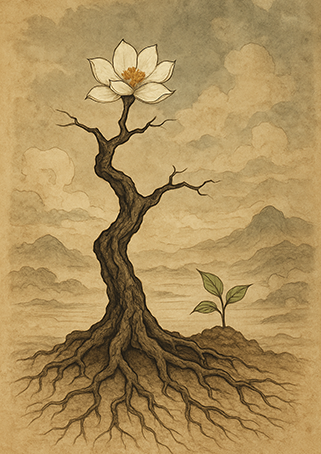Xieyi・The Rootless Tree:24 Chapters-Appendix IV#415

The poems of “The Rootless Tree” express a fundamental force rooted in harmony with heaven and earth, the cyclical flow of yin and yang, and the infinite potential of existence。
This painting is an expressive “Xieyi” in the tradition of “futu” (spiritual diagrams), passed down for generations in Wudang Mountain, China. It is drawn through a technique where energy flow (xingqi) channels the internal intention into visual form。 In the Taoist world, there exist spiritual and symbolic images called “futu”。
In the Taoist world, there exist spiritual and symbolic images called “futu”。
These are a type of talisman—not merely religious items, but expressive spiritual paintings that act directly on the mind of the viewer。
Since ancient times, many people have placed these Taoist-style “Xieyi” and futu in their homes, studies, or bedrooms, wishing for longevity, health, auspiciousness, and family harmony. Viewing such paintings was not just aesthetic appreciation, but an act of inviting the presence of the Dao into one’s life and tuning the body and mind。
Thus, “Xieyi” is more than artistic expression—it is a medium that bridges the spirit, life, and harmony with the universe。
This kind of artwork is not meant to be seen only with the eyes, but felt with the heart。
It communicates with the Dao, resonates with the qi of nature, and quietly stirs the viewer’s inner self。
Futu and “Xieyi” continue to live on from ancient times to this day as “sacred images that speak to the soul.”
Below, we present the original text of the philosophical poem “The Rootless Tree,” along with a modern Japanese translation and interpretation。
※ The author of “The Rootless Tree,” Zhang Sanfeng (1247–?), is also renowned as the founder of Tai Chi, and it is said that he applied the essence of this work to Tai Chi. As an additional note, we include an interpretation connecting this to the Tai Chi tradition of Wudang Mountain.
The Rootless Tree・Appendix IV

▶Original Text
無根樹,花正鮮,咬定根苗莫怠懶。勞心力,歷苦煎,七返九還見自然。
鳳採丹花啼五色,龍銜寶珠弄九天。煉真仙,跨龍船,笑傲風塵不計年。
▶Modern Translation
The flower blooming on the rootless tree is fresh. Firmly chew root and seedling—do not neglect.
Exhaust heart and strength, endure hardship. After seven reversals and nine returns, the Dao’s form appears.
The phoenix picks the red cinnabar flower and sings in five colors. The dragon carries the precious pearl and roams the nine heavens.
Forge the true immortal. Ride the dragon boat. Laugh at the dusty world, counting not the years.
▶Interpretation
• “Seven reversals, nine returns” = repeated cycles of refinement.
• Phoenix and dragon represent divine forces in harmony.
▶Interpretation related to Tai Chi
This is the culmination of Tai Chi training: unconscious movement, pure integration.
Freed from time, one dances in harmony with the Dao, untouched by worldly dust.
Copyright © MASAKI WAKABAYASHI. All rights reserved.




